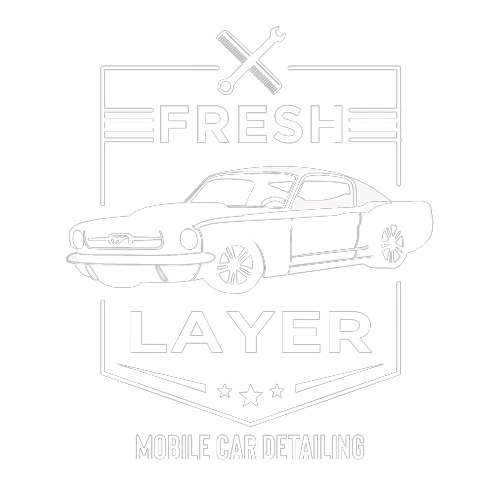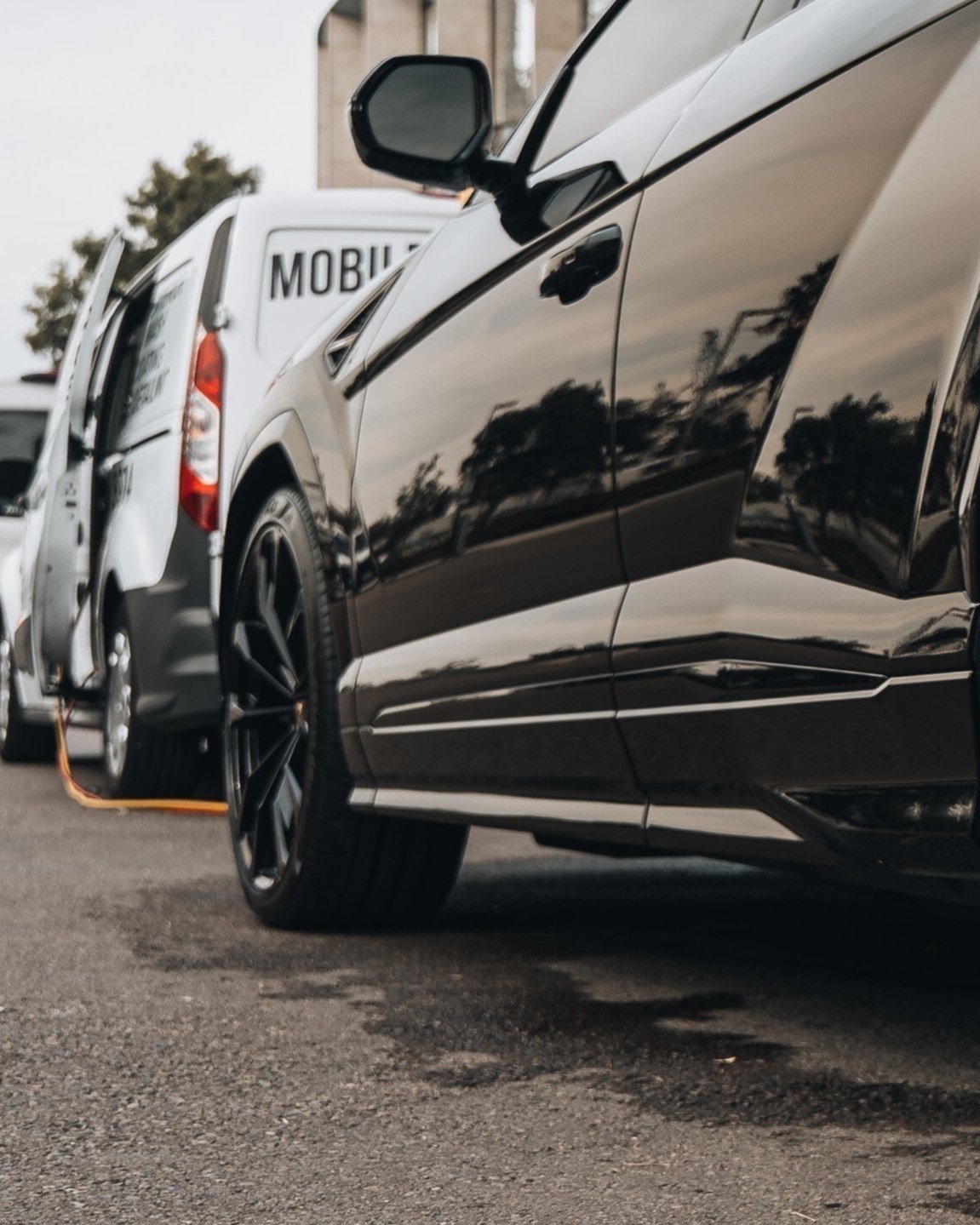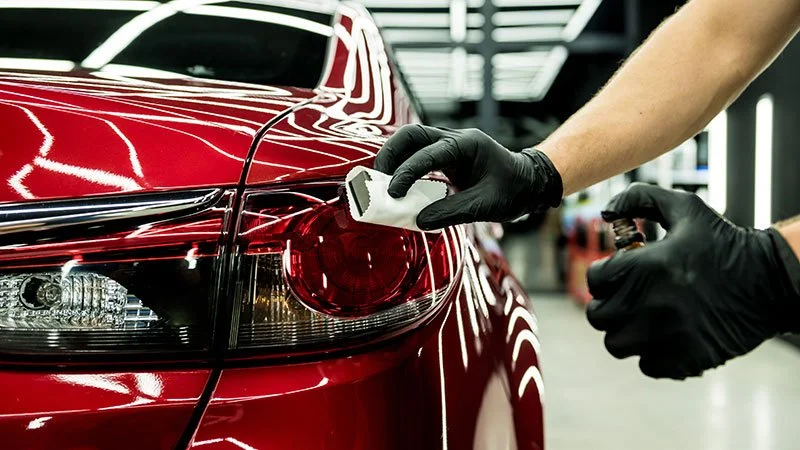Does Ceramic Coating Hide Scratches?
What Is Ceramic Coating?
Ceramic coating is a liquid polymer applied to a car’s exterior that chemically bonds with the factory paint. A ceramic coat serves as a protective layer over your car's paint, enhancing both its appearance and durability. It forms a protective layer, offering benefits such as:
Hydrophobic Properties: Repels water, dirt, and contaminants.
UV Protection: Prevents paint fading and oxidation caused by the sun.
Enhanced Gloss: Enhances your car's finish, providing a shiny, mirror-like appearance.
Durability: Can last for years with proper maintenance.
While ceramic coating is excellent for preserving your car’s paint, its relationship with scratches is more nuanced.
What is a ceramic coating ?
What Is Ceramic Coating?
Ceramic coating is a liquid polymer applied to a car’s exterior that chemically bonds with the factory paint. It forms a protective layer, offering benefits such as:
Hydrophobic Properties: Repels water, dirt, and contaminants.
UV Protection: Prevents paint fading and oxidation caused by the sun.
Enhanced Gloss: Provides a shiny, mirror-like finish.
Durability: Can last for years with proper maintenance.
While ceramic coating is excellent for preserving your car’s paint, its relationship with scratches is more nuanced.
Ceramic Coating and Scratch Resistance
As car enthusiasts and owners, we all strive to maintain the pristine condition of our vehicles. In recent years, ceramic coating has emerged as a popular choice in the automotive care industry. Most car owners seek ceramic coating primarily for paint protection and to prevent scratches.
However, there’s a lot of confusion about what ceramic coating can and cannot do, especially when it comes to scratch resistance.
This article aims to provide an in-depth understanding of ceramic coatings, focusing on their role in scratch resistance and overall car care.
Exploring the Scratch-Resistant Power of Ceramic Coatings
Clarifying the Misconception
It's a common misconception among many car owners that ceramic coatings can remove existing scratches from their vehicles.
However, the truth is quite different. Ceramic coatings do not possess the ability to erase scratches that are already present on the car's surface.
Their primary function is to offer a protective layer that aids in preventing new minor scratches, Uv damage and chemical resistants.
The Short Answer: No
Ceramic coating cannot remove scratches. It is not a paint correction product but a protective layer that sits on top of the paint. However, understanding its role in scratch prevention and paint protection is key.
Why Ceramic Coating Doesn't Remove Scratches
No Abrasive Properties: Unlike polishing compounds, ceramic coating doesn’t have the abrasives needed to level out scratches.
Surface-Level Application: It bonds to the paint but doesn’t fill or repair damage beneath the surface. Ceramic coatings are transparent and do not fill or repair the clear coating, which is where many surface scratches on a car's paint surface reside.
Purpose: Its main function is to protect against new damage, not to fix existing issues.
How Does the Ceramic Coating Protect Your Paint?
Applying a ceramic coating to your vehicle is one of the most effective ways to safeguard your car’s paint surface.
When you apply a ceramic coating, it forms a hard, transparent protective layer that bonds directly to the paint. This layer is designed to be scratch resistant, helping to reduce the chances of new scratches and swirl marks forming from everyday use.
While ceramic coatings are not completely scratch proof, they do provide excellent protection against minor scratches and the kind of light abrasions that can occur during washing or from environmental contaminants.
The protective layer acts as a barrier, shielding your car’s paint from harmful UV rays, bird droppings, acid rain, and other damaging elements that can degrade the finish over time.
For car owners, this means less worry about the small imperfections that can accumulate on a vehicle’s surface.
By applying a ceramic coating, you’re investing in long-lasting paint protection that keeps your car looking newer for longer. The result is a paint surface that resists scratches and swirl marks, maintains its gloss, and stands up better to the rigors of daily driving and exposure to the elements.
Protecting your car's surface from environmental damage is essential to maintaining its appearance and value.
Ceramic coatings protect a vehicle’s paint and the vehicle's exterior from new scratches primarily through the creation of a hard, protective layer over the original paint. Here’s how it works:
Enhanced Hardness and Durability
Professional Insight: Automotive professionals often emphasize the importance of the increased hardness that ceramic coatings provide.
The layer formed by a ceramic coating is significantly harder than the vehicle’s original paint. A ceramic coated car benefits from enhanced surface hardness and durability, offering superior protection against scratches and environmental contaminants.
Mohs Scale Rating: Many ceramic coatings have a Mohs hardness rating that significantly exceeds that of standard clear coats. This increased hardness means that the paint surface, once ceramic coated, is more resistant to scratches that might occur from everyday interactions, such as brushing against the car with clothing or bags, or light abrasions from washing.
Chemical Bonding: Unlike waxes or sealants that merely sit on top of the car’s paint, ceramic coatings bond chemically with the paint. This bond ensures a durable protective layer that doesn’t wash away or break down easily, providing long-term scratch resistance.
What Ceramic Coating Can Do for Scratches
While ceramic coating cannot remove scratches, it can reduce the visibility of small scratches by filling in minor imperfections and enhancing gloss. However, ceramic coating does not remove swirl marks—these require polishing or paint correction to eliminate.
1. Hide Minor Imperfections
Ceramic coating may reduce the visibility of shallow swirl marks, micro-scratches, or small scratches by enhancing the paint’s gloss.
These imperfections, including small scratches, may become less noticeable under the reflective finish.
2. Prevent New Scratches
The protective layer can guard against light scratches caused by:
Dust and dirt rubbing against the surface during cleaning.
Minor abrasions from keys or clothing.
When combined with proper washing techniques, ceramic coating can help prevent swirl marks from forming on your vehicle's surface.
Note: Ceramic coating is not bulletproof and will not prevent deep scratches from accidents or hard impacts.
3. Extend Paint Longevity
By reducing exposure to environmental contaminants and UV rays, ceramic coating helps maintain the integrity of your vehicle's paint over time.
Preventing Swirl Marks with Ceramic Coating
Swirl marks are a common frustration for car owners who want to keep their paint surface looking flawless.
Fortunately, ceramic coating offers a powerful solution for preventing swirl marks and minor scratches.
The slick surface created by a ceramic coating repels water, dust, and other contaminants, making it much harder for debris to stick and cause damage during cleaning.
To maximize the swirl mark prevention benefits of ceramic coating, it’s important to use proper washing techniques.
The two-bucket method—one bucket for soapy water and another for rinsing your wash mitt—helps prevent dirt from being reintroduced to the paint surface. Pairing this with high-quality microfiber towels further reduces the risk of inducing scratches or swirl marks during washing and drying.
Applying a ceramic coating not only makes your car easier to clean, but also helps maintain the paint gloss and overall appearance by preventing the buildup of swirl marks.
For car owners who value a pristine finish, combining ceramic coating with careful washing habits is an excellent investment in the long-term beauty and protection of your vehicle’s paint surface.
WHAT IS THE MOHS HARDNESS SCALE?
TThe actual hardness of a ceramic coating compared to a vehicle’s original paint can be quantified using the Mohs scale, a scale that measures the hardness of minerals. The Mohs scale ranges from 1 (very soft) to 10 (very hard).
Vehicle Paint Hardness:
Standard automotive paint typically falls between 3 and 4 on the Mohs scale. This measurement takes into account the clear coat, which is the outermost layer of automotive paint and the primary barrier against scratches.
Ceramic Coating Hardness:
When a ceramic coating is applied, it can increase the hardness of the paint surface. The coating is able to penetrate porous materials, such as the microscopic imperfections in automotive paint, providing enhanced protection and durability.
Many ceramic coatings claim to reach a hardness level of around 9H on the Mohs scale. The “H” in 9H stands for the pencil hardness test, which is commonly used in the coating industry. It’s worth noting that this scale is different from the standard Mohs scale, but the 9H rating is often marketed to suggest a significant increase in surface hardness.
Ceramic Coating Reduced Surface Friction
Industry Viewpoint: The hydrophobic nature of ceramic coatings is highly valued in the automotive care industry.
Water Repellency: Ceramic coatings repel water, causing it to bead up and slide off the surface. This effect also helps in carrying away dirt and debris, which might otherwise adhere to the surface and cause scratches.
Easier Cleaning: The hydrophobic effect makes cleaning the vehicle much easier and safer. Less force and friction are needed to remove dirt, thereby reducing the risk of inducing scratches during washes. For best results, always use a microfiber drying towel that is completely clean to avoid streaks or residue. Hand wash is recommended as the preferred method for cleaning a ceramic coated car to prevent scratches.
Hydrophobic Properties
Industry Viewpoint: The hydrophobic nature of ceramic coatings is highly valued in the automotive care industry.
Water Repellency: Ceramic coatings repel water, causing it to bead up and slide off the surface. This effect also helps in carrying away dirt and debris, which might otherwise adhere to the surface and cause scratches.
Easier Cleaning: The hydrophobic effect makes cleaning the vehicle much easier and safer. Less force and friction are needed to remove dirt, thereby reducing the risk of inducing scratches during washes.
Protection Against Environmental Factors
Professional Consensus: Environmental factors are a significant cause of minor scratches and swirl marks.
Resistance to Contaminants: Ceramic coatings provide a barrier against environmental contaminants like bird droppings, tree sap, and acid rain, all of which can etch or scratch the paint if not removed promptly. The vehicle's surface is shielded from these harmful elements, helping maintain its appearance and integrity.
UV Protection: The coating also protects against UV rays, preventing the paint from oxidizing and becoming brittle, which can make it more susceptible to scratching.
How to Address Scratches Effectively
Step 1: Assess the Damage
Surface Scratches: Minor imperfections that affect only the clear coat.
Deep Scratches: Damage that penetrates the paint layer and exposes the metal.
Step 2: Choose the Right Solution
If you're looking to repair car scratches, consider the following methods:
Polishing: For surface scratches, use a polish to level the clear coat.
Paint Correction: For deeper scratches, a professional detailer can perform multi-stage correction to restore the surface.
Touch-Up Paint: For severe damage, repainting may be necessary.
Step 3: Apply Ceramic Coating Post-Repair
Once scratches are corrected, apply ceramic coating to protect the restored surface and prevent future damage.
Professional Application and Maintenance
How To Maintain Ceramic Coating?
At Fresh Layer Mobile Detailing We provide Step By Step Guide how to wash your ceramic coated car with all tools you will need
Detailers’ Recommendations: For maximum effectiveness, professionals recommend proper application and maintenance of ceramic coatings.
Skillful Application: The process of applying a ceramic coating is meticulous and usually best left to professionals. For optimal results, ceramic coatings should be applied in a controlled environment, such as a detailing shop, to ensure proper curing and maximum durability. An evenly applied, high-quality ceramic coating maximizes scratch resistance.
Regular Maintenance: Regular washing and occasional top-up applications can maintain the integrity and effectiveness of the coating.
Limitations and Realistic Expectations
Expert Advice: It's essential to understand that while ceramic coatings significantly increase scratch resistance, they are not a panacea.
Not Scratch Proof: No coating can make a car completely scratch-proof. Ceramic coatings are designed to resist minor scratches but may not protect against deeper gouges or impacts.
Regular Inspections: Regular inspections for any damage and timely repairs can prolong the life of both the coating and the paint underneath.
In conclusion, ceramic coatings provide a significant level of protection against new scratches through enhanced hardness, reduced friction, hydrophobic effect.
The Role of Ceramic Coating in Protecting Against Future Scratches
Composition and Properties
Ceramic coatings are composed of advanced chemical polymers that bond with the vehicle's surface, with a clear coat specifically creating a protective layer. This layer is renowned for its hardness, hydrophobic properties, water biting and resistance to chemical environmental contaminants.
Protection Mechanism
The primary role of ceramic coatings is to shield the vehicle's paint from various damaging elements like UV rays, bird droppings, and chemical etchants, thereby preserving the underlying paintwork.
Scratch Differences
It's vital to distinguish between light scratches, which only affect the coating, and deep scratches that penetrate to the paint layer. This difference dictates the approach to scratch removal. Ceramic coating can't protect from scratches, but it can help to avoid the majority of them.
Ceramic Coating: Shine Like New, but Don't Expect Superhuman Defenses!
Love the idea of a gleaming, scratch-resistant car? Ceramic coating sounds tempting, but hold on. While it excels at boosting shine and repelling grime, it's not a superhero against scratches. Here's why:
Microscopic Defense: Think of ceramic coating as a super-thin, ultra-smooth shield. It fills in minor imperfections, but deep scratches still pierce through.
Hardness Matters: Diamond is nature's scratchproof champ, but ceramic coatings? Not even close. While they're harder than your car's paint, fingernail-deep gouges won't magically disappear.
Prevention, not Repair: Ceramic coating excels at preventing future scratches thanks to its slick surface, but it won't erase existing damage. Think of it as sunscreen, not scar cream.
Frequently Asked Questions
-
Ceramic coating cannot fix swirl marks, but it can hide them by enhancing the gloss of the paint.
-
No. Ceramic coating is scratch-resistant, meaning it can withstand light abrasions but not deep scratches or impacts.
-
Yes. Always repair scratches through polishing or paint correction before applying ceramic coating to ensure the best results.
-
With proper care, ceramic coating can last 2-5 years or longer, depending on the product and application method.
-
While DIY kits are available, professional application ensures optimal bonding and durability.
Statistics on Ceramic Coating and Paint Protection
70% of car owners report that ceramic coating improves the overall appearance of their vehicle.
Vehicles with ceramic coating are 50% easier to clean compared to uncoated cars.
60% of scratches occur during improper washing; ceramic coating reduces this risk significantly.
So, ditch the scratch-proof myth and embrace ceramic coating for what it is: a fantastic way to keep your car looking stunning while making it easier to clean. Consider it an investment in shine and protection, not invincibility.
Want a truly scratch-resistant ride? Buff out existing scratches before applying ceramic coating for a smoother finish. For deeper blemishes, consult a professional paint correction expert.
Remember, your car deserves the best! Choose ceramic coating for the right reasons and enjoy the dazzling results.
Conclusion
Ceramic coating is a powerful tool for protecting and enhancing your car's paint, but it's not a solution for removing scratches. Understanding its role and limitations helps you make informed decisions about your vehicle's care.
To tackle scratches effectively, combine paint correction with ceramic coating for long-lasting protection. By addressing imperfections first and adding a durable layer of ceramic coating, you can enjoy a car that looks pristine for years to come.
So, is ceramic coating worth it? Absolutely—as long as you pair it with the right scratch repair methods. Don't let scratches ruin your car's appearance—act now and preserve its beauty with the right solutions.









